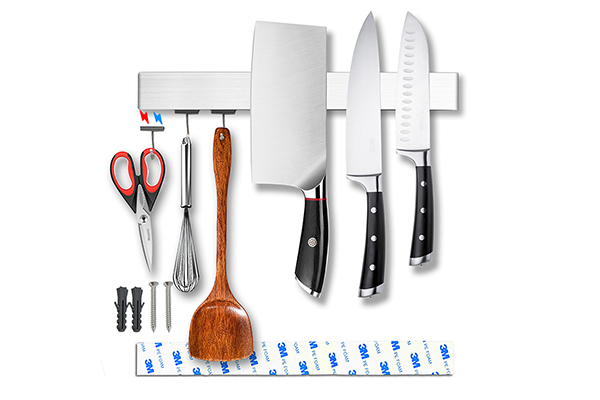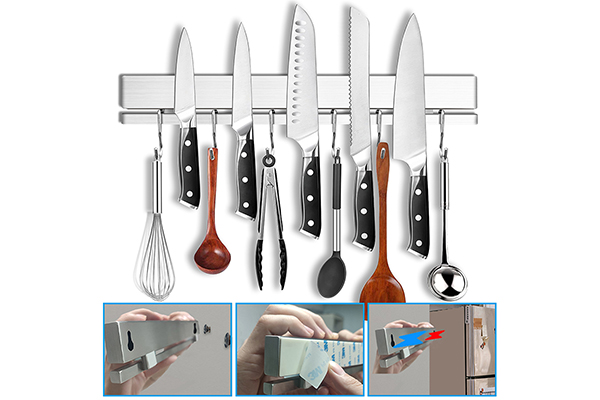Exploration on the cleaning and maintenance process of the magnetic surface of the magnetic knife holder and the anti-fouling coating technology
Release Time : 2025-04-16
The magnetic surface of the magnetic knife holder is in contact with the knife for a long time, and it is easy to be contaminated with oil, water stains and metal debris. Its cleaning, maintenance and anti-fouling treatment are crucial to extend the service life and maintain the adsorption performance.
There are many difficulties in cleaning and maintaining the magnetic surface of the magnetic knife holder. Since the magnetic surface relies on magnetic force to adsorb knives, during daily use, the oil and food residues on the knives will continue to adhere to the magnetic surface. At the same time, the friction generated when the knife contacts the magnetic surface will cause metal debris to be adsorbed on the magnetic surface. These debris not only affect the appearance, but may also scratch the magnetic surface. In addition, the kitchen environment is humid, and water stains are easy to remain. Long-term accumulation will cause the magnetic surface to rust, affecting the magnetic performance and service life. Moreover, the special structure and magnetic properties of the magnetic surface make it difficult for some conventional cleaning tools and methods to work effectively. For example, it is difficult for ordinary rags to completely remove stubborn stains and adsorbed metal debris, which increases the difficulty of cleaning and maintenance.
For the cleaning of the magnetic surface of the magnetic knife holder, physical cleaning methods can be used first. Use a soft brush or anti-static brush to gently brush along the texture of the magnetic surface to effectively remove metal debris and fine dust attached to the surface. For oil stains and food residues, use a soft cloth soaked in a mild detergent solution to wipe. When choosing a detergent, avoid using corrosive chemical detergents to avoid damaging the material and magnetic coating of the magnetic surface. Use moderate force when wiping to prevent excessive scratching of the magnetic surface. After cleaning, wipe the magnetic surface dry with a clean dry cloth to avoid water stains. In addition, for some stubborn stains that are difficult to remove, you can use a strong adhesive tape to gently stick it to the stain, then tear it off and use the stickiness of the tape to remove the stain, but be careful to choose a tape that will not leave glue to prevent secondary contamination.
Chemical cleaning methods are also important in the maintenance of the magnetic surface of the magnetic knife holder. For severe oil stains, you can use a special kitchen oil stain cleaner. This type of cleaner usually contains ingredients such as surfactants, which can effectively decompose oil stains. When using, spray the detergent evenly on the magnetic surface, let it stand for a while, wait for the oil to fully dissolve, and then wipe it clean with a soft cloth. For rusted parts, chemical reagents containing rust removal ingredients can be used for treatment. However, before using chemical reagents, it is necessary to conduct a small-scale test on an inconspicuous position on the magnetic surface to ensure that the reagent will not damage the magnetic surface. After rust removal, rinse it with clean water in time and wipe the surface dry to prevent rust again. When using chemical cleaning methods, pay attention to ventilation and avoid inhaling harmful gases. At the same time, strictly follow the product instructions to ensure safety.
Anti-fouling coating technology is the key to improving the anti-fouling ability of the magnetic surface of the magnetic knife holder. Nano-coating technology has attracted much attention in the field of anti-fouling due to its unique properties. Nano-coating has the characteristics of super-hydrophobicity and super-oleophobicity, and can form an extremely thin protective film on the magnetic surface, making it difficult for oil and water stains to adhere. When oil or water stains drip on the magnetic surface coated with nano-coating, they will form water or oil droplets, which can be removed with a light wipe, greatly reducing the difficulty of cleaning. In addition, the coating has a high hardness and can effectively resist the scratches caused by the friction between the tool and the magnetic surface, protecting the surface structure of the magnetic surface. There are also some self-cleaning coatings that can decompose organic pollutants on the surface under the action of light or oxygen in the air, achieve the effect of automatic cleaning, and further reduce the frequency of manual cleaning.
In terms of the construction process of anti-fouling coatings, there are currently mainly methods such as spraying, dipping and vapor deposition. The spraying method is easy to operate and is suitable for large-area magnetic knife holder magnetic surface coating construction. By adjusting the parameters of the spray gun, the thickness and uniformity of the coating can be controlled. The dipping method is to immerse the magnetic knife holder in the coating solution so that the coating material is evenly attached to the magnetic surface. This method can ensure the integrity of the coating, but there may be problems with the coating thickness that is difficult to control. The vapor deposition method is to vaporize the coating material into a molecular or atomic state under a vacuum environment, and then deposit it on the surface of the magnetic surface to form a uniform and dense coating. This method can obtain high-quality coatings, but the equipment cost is high and the process is complicated. In practical applications, it is necessary to select a suitable construction process according to factors such as the material, use environment and cost of the magnetic knife holder to ensure the performance and quality of the antifouling coating.
In addition to the performance and construction process of the coating itself, the bonding force between the coating and the magnetic surface is also an important factor affecting the antifouling effect. In order to enhance the bonding force between the coating and the magnetic surface, the magnetic surface usually needs to be pretreated. For example, the surface of the magnetic surface is roughened by sandblasting, grinding, etc., to increase the specific surface area of the surface and improve the adhesion of the coating. Chemical treatment methods can also be used to form a transition layer on the surface of the magnetic surface to improve the compatibility of the coating with the magnetic surface. In addition, during the coating construction process, controlling the appropriate temperature and humidity conditions, as well as the curing time and method of the coating, can also help improve the bonding force between the coating and the magnetic surface, ensuring that the antifouling coating will not fall off during long-term use.
The cleaning and maintenance process of the magnetic surface of the magnetic knife holder and the antifouling coating technology are important links to ensure its performance and service life. By rationally using physical and chemical cleaning methods, selecting appropriate antifouling coating technology and construction techniques, and focusing on the bonding strength between the coating and the magnetic surface, the magnetic surface can be effectively kept clean, its antifouling ability can be improved, and a more convenient and efficient use experience can be provided to users. With the continuous development of material science and surface treatment technology, more innovative cleaning and maintenance methods and high-performance antifouling coatings will appear in the future to further optimize the performance of the magnetic knife holder.








